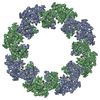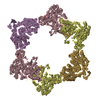+ Open data
Open data
- Basic information
Basic information
| Entry | Database: PDB / ID: 7mue | |||||||||||||||
|---|---|---|---|---|---|---|---|---|---|---|---|---|---|---|---|---|
| Title | Legionella pneumophila Dot/Icm T4SS PR | |||||||||||||||
 Components Components |
| |||||||||||||||
 Keywords Keywords | TRANSLOCASE / Dot/Icm / Secretion / T4SS | |||||||||||||||
| Function / homology |  Function and homology information Function and homology information | |||||||||||||||
| Biological species |  | |||||||||||||||
| Method | ELECTRON MICROSCOPY / single particle reconstruction / cryo EM / Resolution: 2.8 Å | |||||||||||||||
 Authors Authors | Sheedlo, M.J. / Durie, C.L. / Swanson, M. / Lacy, D.B. / Ohi, M.D. | |||||||||||||||
| Funding support |  United States, 4items United States, 4items
| |||||||||||||||
 Citation Citation |  Journal: Elife / Year: 2021 Journal: Elife / Year: 2021Title: Cryo-EM reveals new species-specific proteins and symmetry elements in the Dot/Icm T4SS. Authors: Michael J Sheedlo / Clarissa L Durie / Jeong Min Chung / Louise Chang / Jacquelyn Roberts / Michele Swanson / Dana Borden Lacy / Melanie D Ohi /   Abstract: is an opportunistic pathogen that causes the potentially fatal pneumonia known as Legionnaires' disease. The pathology associated with infection depends on bacterial delivery of effector proteins ... is an opportunistic pathogen that causes the potentially fatal pneumonia known as Legionnaires' disease. The pathology associated with infection depends on bacterial delivery of effector proteins into the host via the membrane spanning Dot/Icm type IV secretion system (T4SS). We have determined sub-3.0 Å resolution maps of the Dot/Icm T4SS core complex by single particle cryo-EM. The high-resolution structural analysis has allowed us to identify proteins encoded outside the Dot/Icm genetic locus that contribute to the core T4SS structure. We can also now define two distinct areas of symmetry mismatch, one that connects the C18 periplasmic ring (PR) and the C13 outer membrane cap (OMC) and one that connects the C13 OMC with a 16-fold symmetric dome. Unexpectedly, the connection between the PR and OMC is DotH, with five copies sandwiched between the OMC and PR to accommodate the symmetry mismatch. Finally, we observe multiple conformations in the reconstructions that indicate flexibility within the structure. | |||||||||||||||
| History |
|
- Structure visualization
Structure visualization
| Movie |
 Movie viewer Movie viewer |
|---|---|
| Structure viewer | Molecule:  Molmil Molmil Jmol/JSmol Jmol/JSmol |
- Downloads & links
Downloads & links
- Download
Download
| PDBx/mmCIF format |  7mue.cif.gz 7mue.cif.gz | 1.2 MB | Display |  PDBx/mmCIF format PDBx/mmCIF format |
|---|---|---|---|---|
| PDB format |  pdb7mue.ent.gz pdb7mue.ent.gz | Display |  PDB format PDB format | |
| PDBx/mmJSON format |  7mue.json.gz 7mue.json.gz | Tree view |  PDBx/mmJSON format PDBx/mmJSON format | |
| Others |  Other downloads Other downloads |
-Validation report
| Summary document |  7mue_validation.pdf.gz 7mue_validation.pdf.gz | 1.1 MB | Display |  wwPDB validaton report wwPDB validaton report |
|---|---|---|---|---|
| Full document |  7mue_full_validation.pdf.gz 7mue_full_validation.pdf.gz | 1.1 MB | Display | |
| Data in XML |  7mue_validation.xml.gz 7mue_validation.xml.gz | 109.9 KB | Display | |
| Data in CIF |  7mue_validation.cif.gz 7mue_validation.cif.gz | 175.7 KB | Display | |
| Arichive directory |  https://data.pdbj.org/pub/pdb/validation_reports/mu/7mue https://data.pdbj.org/pub/pdb/validation_reports/mu/7mue ftp://data.pdbj.org/pub/pdb/validation_reports/mu/7mue ftp://data.pdbj.org/pub/pdb/validation_reports/mu/7mue | HTTPS FTP |
-Related structure data
| Related structure data |  24006MC  7mucC  7mudC  7muqC  7musC  7muvC  7muwC  7muyC M: map data used to model this data C: citing same article ( |
|---|---|
| Similar structure data |
- Links
Links
- Assembly
Assembly
| Deposited unit | 
|
|---|---|
| 1 |
|
- Components
Components
| #1: Protein | Mass: 29729.969 Da / Num. of mol.: 18 / Source method: isolated from a natural source / Source: (natural)  #2: Protein | Mass: 38958.926 Da / Num. of mol.: 18 / Source method: isolated from a natural source / Source: (natural)  #3: Protein/peptide | Mass: 4103.049 Da / Num. of mol.: 18 / Source method: isolated from a natural source / Source: (natural)  #4: Protein | Mass: 107911.891 Da / Num. of mol.: 18 / Source method: isolated from a natural source / Source: (natural)  Sequence details | The protein fragment sequence could not be directly identified as the sample was purified from a ...The protein fragment sequence could not be directly identified as the sample was purified from a native source. | |
|---|
-Experimental details
-Experiment
| Experiment | Method: ELECTRON MICROSCOPY |
|---|---|
| EM experiment | Aggregation state: PARTICLE / 3D reconstruction method: single particle reconstruction |
- Sample preparation
Sample preparation
| Component | Name: Legionella pneumophila Dot/Icm T4SS PR / Type: COMPLEX / Entity ID: all / Source: NATURAL |
|---|---|
| Molecular weight | Experimental value: NO |
| Source (natural) | Organism:  |
| Buffer solution | pH: 8 |
| Specimen | Embedding applied: NO / Shadowing applied: NO / Staining applied: NO / Vitrification applied: YES |
| Vitrification | Cryogen name: ETHANE |
- Electron microscopy imaging
Electron microscopy imaging
| Experimental equipment |  Model: Titan Krios / Image courtesy: FEI Company |
|---|---|
| Microscopy | Model: FEI TITAN KRIOS |
| Electron gun | Electron source:  FIELD EMISSION GUN / Accelerating voltage: 300 kV / Illumination mode: FLOOD BEAM FIELD EMISSION GUN / Accelerating voltage: 300 kV / Illumination mode: FLOOD BEAM |
| Electron lens | Mode: BRIGHT FIELD |
| Image recording | Electron dose: 50 e/Å2 / Film or detector model: GATAN K3 (6k x 4k) |
- Processing
Processing
| Software |
| ||||||||||||||||||||||||
|---|---|---|---|---|---|---|---|---|---|---|---|---|---|---|---|---|---|---|---|---|---|---|---|---|---|
| CTF correction | Type: PHASE FLIPPING AND AMPLITUDE CORRECTION | ||||||||||||||||||||||||
| 3D reconstruction | Resolution: 2.8 Å / Resolution method: FSC 0.143 CUT-OFF / Num. of particles: 43907 / Symmetry type: POINT | ||||||||||||||||||||||||
| Atomic model building | Protocol: AB INITIO MODEL | ||||||||||||||||||||||||
| Refinement | Cross valid method: NONE Stereochemistry target values: GeoStd + Monomer Library + CDL v1.2 | ||||||||||||||||||||||||
| Displacement parameters | Biso mean: 57.01 Å2 | ||||||||||||||||||||||||
| Refine LS restraints |
|
 Movie
Movie Controller
Controller














 PDBj
PDBj




